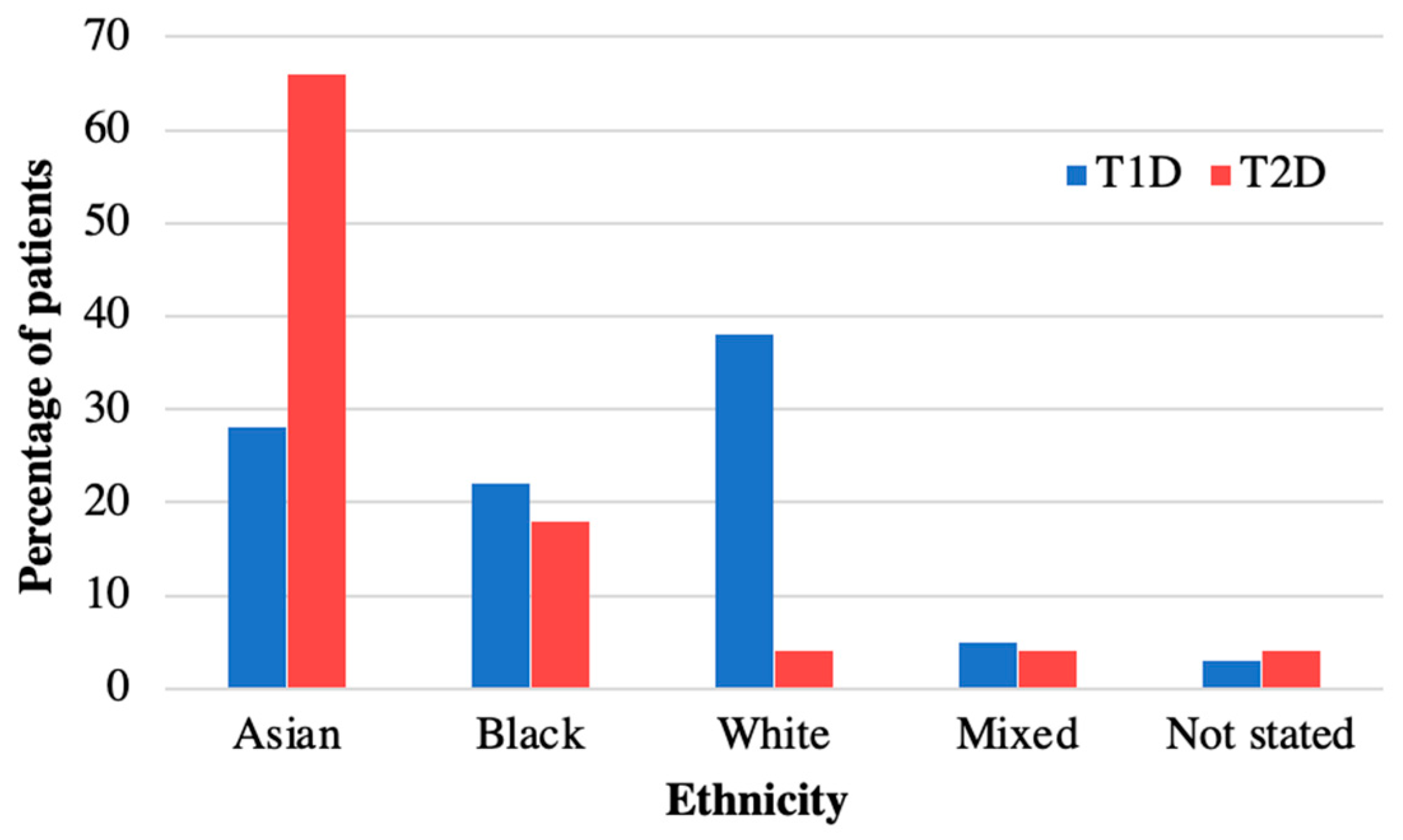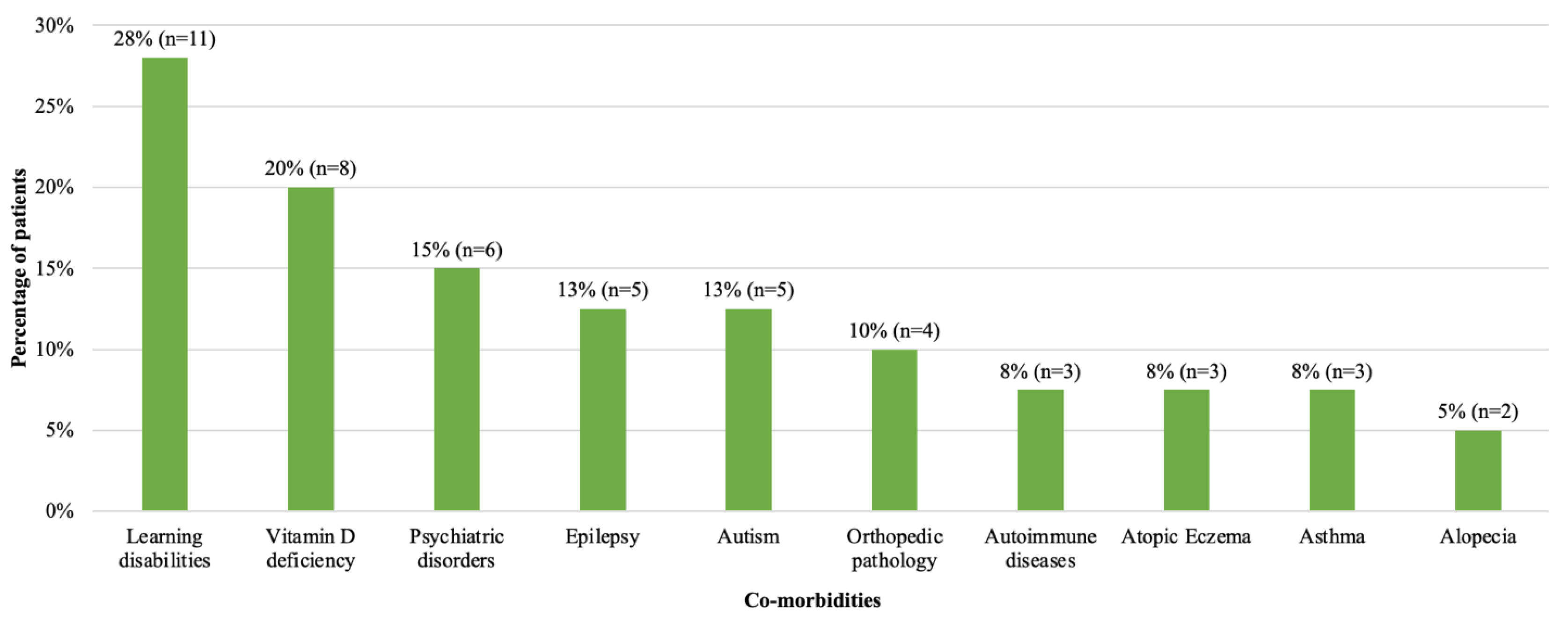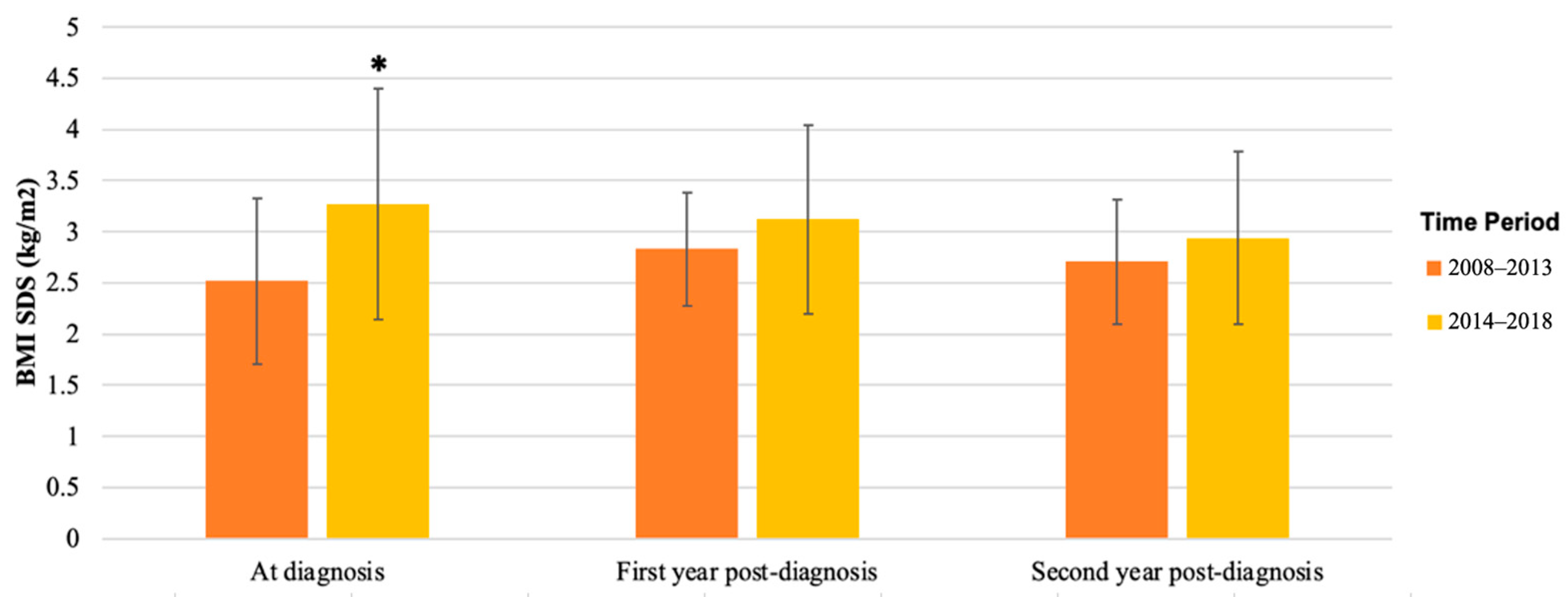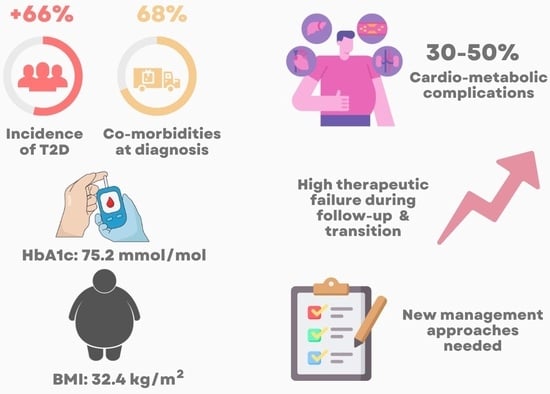Exploring the Surge in Paediatric Type 2 Diabetes in an Inner-City London Centre—A Decade-Long Analysis of Incidence, Outcomes, and Transition
Abstract
:1. Introduction
2. Materials and Methods
2.1. Data Collection
2.2. Statistical Analyses
3. Results
3.1. Participant Characteristics at Diagnosis
3.1.1. Clinical Parameters
Co-Morbidities and Antibody Status
BMI and BMI SDS
HbA1c
Complications
Treatment
3.2. Clinical Progression during Treatment Follow-Up
3.2.1. Clinical Parameters
BMI and BMI SDS
HbA1c
Complications
Treatment and HbA1c Outcomes
3.3. Clinical Outcomes following Transition to Adult Care Services
4. Discussion
4.1. Epidemiology
4.2. Clinical Parameters
4.3. Complications
4.4. Treatment
5. Conclusions
Supplementary Materials
Author Contributions
Funding
Institutional Review Board Statement
Informed Consent Statement
Data Availability Statement
Acknowledgments
Conflicts of Interest
References
- Facts & Figures. Diabetes UK. 2019. Available online: https://www.diabetes.org.uk/professionals/position-statements-reports/statistics (accessed on 10 November 2022).
- Diabetes Prevalence. 2022. Available online: https://www.diabetes.co.uk/diabetes-prevalence.html (accessed on 10 November 2022).
- Pinhas-Hamiel, O.; Zeitler, P. The global spread of type 2 diabetes mellitus in children and adolescents. J. Pediatr. 2005, 146, 693–700. [Google Scholar] [CrossRef]
- Dabelea, D.; Mayer-Davis, E.J.; Saydah, S.; Imperatore, G.; Linder, B.; Divers, J.; Bell, R.; Badaru, A.; Talton, J.W.; Crume, T.; et al. Prevalence of type 1 and type 2 diabetes among children and adolescents from 2001 to 2009. JAMA 2014, 311, 1778–1786. [Google Scholar] [CrossRef] [PubMed]
- Han, J.C.; Lawlor, D.A.; Kimm, S.Y. Childhood obesity. Lancet 2010, 375, 1737–1748. [Google Scholar] [CrossRef]
- Royal College of Paediatrics and Child Health. NPDA Spotlight Audit Report on the Diagnosis and Management of Type 2 Diabetes; Royal College of Paediatrics and Child Health: London, UK, 2021. [Google Scholar]
- Candler, T.P.; Mahmoud, O.; Lynn, R.M.; Majbar, A.A.; Barrett, T.G.; Shield, J.P. Continuing rise of type 2 diabetes incidence in children and young people in the UK. Diabet. Med. 2018, 35, 737–744. [Google Scholar] [CrossRef] [PubMed]
- Shaw, J.E.; Sicree, R.A.; Zimmet, P.Z. Global estimates of the prevalence of diabetes for 2010 and 2030. Diabetes Res. Clin. Pract. 2010, 87, 4–14. [Google Scholar] [CrossRef] [PubMed]
- Pulgaron, E.R.; Delamater, A.M. Obesity and type 2 diabetes in children: Epidemiology and treatment. Curr. Diabetes Rep. 2014, 14, 508. [Google Scholar] [CrossRef]
- Shah, A.; Kanaya, A.M. Diabetes and associated complications in the South Asian population. Curr. Cardiol. Rep. 2014, 16, 476. [Google Scholar] [CrossRef]
- Dabelea, D.; Bell, R.A.; D’Agostino, R.B., Jr.; Imperatore, G.; Johansen, J.M.; Linder, B.; Liu, L.L.; Loots, B.; Marcovina, S.; Mayer-Davis, E.J.; et al. Incidence of diabetes in youth in the United States. JAMA 2007, 297, 2716–2724. [Google Scholar]
- Tang, M.; Chen, Y.; Krewski, D. Gender-related differences in the association between socioeconomic status and self-reported diabetes. Int. J. Epidemiol. 2003, 32, 381–385. [Google Scholar] [CrossRef]
- Delva, J.; O’Malley, P.M.; Johnston, L.D. Racial/ethnic and socioeconomic status differences in overweight and health-related behaviors among American students: National trends 1986–2003. J. Adolesc. Health 2006, 39, 536–545. [Google Scholar] [CrossRef]
- Greenspan, F.; Shoback, D.; Gardner, D. Pancreatic Hormones & Diabetes Mellitus. In Greenspan’s Basic & Clinical Endocrinology, 9th ed.; McGraw-Hill Education: New York, NY, USA, 2011; Chapter 17; pp. 573–657. [Google Scholar]
- D’Adamo, E.; Caprio, S. Type 2 diabetes in youth: Epidemiology and pathophysiology. Diabetes Care 2011, 34 (Suppl. S2), S161–S165. [Google Scholar] [CrossRef]
- Weiss, R.; Taksali, S.E.; Tamborlane, W.V.; Burgert, T.S.; Savoye, M.; Caprio, S. Predictors of changes in glucose tolerance status in obese youth. Diabetes Care 2005, 28, 902–909. [Google Scholar] [CrossRef] [PubMed]
- Kleber, M.; Lass, N.; Papcke, S.; Wabitsch, M.; Reinehr, T. One-year follow-up of untreated obese white children and adolescents with impaired glucose tolerance: High conversion rate to normal glucose tolerance 1. Diabet. Med. 2010, 27, 516–521. [Google Scholar] [CrossRef] [PubMed]
- Kao, K.T.; Sabin, M.A. Type 2 diabetes mellitus in children and adolescents. Aust. Fam. Physician 2016, 45, 401. [Google Scholar]
- Eppens, M.C.; Craig, M.E.; Jones, T.W.; Silink, M.; Ong, S.; Ping, Y.J.; International Diabetes Federation Western Pacific Region Steering Committee. Type 2 diabetes in youth from the Western Pacific region: Glycaemic control, diabetes care and complications. Curr. Med. Res. Opin. 2006, 22, 1013–1020. [Google Scholar] [CrossRef]
- Ruhayel, S.D.; James, R.A.; Ehtisham, S.; Cameron, F.J.; Werther, G.A.; Sabin, M.A. An observational study of type 2 diabetes within a large Australian tertiary hospital pediatric diabetes service. Pediatr. Diabetes 2010, 11, 544–551. [Google Scholar] [CrossRef] [PubMed]
- Copeland, K.C.; Zeitler, P.; Geffner, M.; Guandalini, C.; Higgins, J.; Hirst, K.; Kaufman, F.R.; Linder, B.; Marcovina, S.; McGuigan, P.; et al. Characteristics of adolescents and youth with recent-onset type 2 diabetes: The TODAY cohort at baseline. J. Clin. Endocrinol. Metab. 2011, 96, 159–167. [Google Scholar] [CrossRef] [PubMed]
- Dart, A.B.; Martens, P.J.; Rigatto, C.; Brownell, M.D.; Dean, H.J.; Sellers, E.A. Earlier onset of complications in youth with type 2 diabetes. Diabetes Care 2014, 37, 436–443. [Google Scholar] [CrossRef]
- Katz, L.E.; Magge, S.N.; Hernandez, M.L.; Murphy, K.M.; McKnight, H.M.; Lipman, T. Glycemic control in youth with type 2 diabetes declines as early as two years after diagnosis. J. Pediatr. 2011, 158, 106–111. [Google Scholar] [CrossRef]
- Australian Institute of Health and Welfare. Type 2 Diabetes in Australia’s Children and Young People: A Working Paper; AIHW: Canberra, Australia, 2014. [Google Scholar]
- Nadeau, K.J.; Anderson, B.J.; Berg, E.G.; Chiang, J.L.; Chou, H.; Copeland, K.C.; Hannon, T.S.; Huang, T.T.; Lynch, J.L.; Powell, J.; et al. Youth-onset type 2 diabetes consensus report: Current status, challenges, and priorities. Diabetes Care 2016, 39, 1635–1642. [Google Scholar] [CrossRef]
- TODAY Study Group. A clinical trial to maintain glycemic control in youth with type 2 diabetes. N. Engl. J. Med. 2012, 366, 2247–2256. [Google Scholar] [CrossRef]
- Zeitler, P.; Arslanian, S.; Fu, J.; Pinhas-Hamiel, O.; Reinehr, T.; Tandon, N.; Urakami, T.; Wong, J.; Maahs, D.M. ISPAD clinical practice consensus guidelines 2018: Type 2 diabetes mellitus in youth. Pediatr. Diabetes 2018, 19, 28–46. [Google Scholar] [CrossRef] [PubMed]
- Cole, T.J.; Freeman, J.V.; Preece, M.A. Body mass index reference curves for the UK, 1990. Arch. Dis. Child. 1995, 73, 25–29. [Google Scholar] [CrossRef] [PubMed]
- National High Blood Pressure Education Program Working Group on High Blood Pressure in Children and Adolescents. The fourth report on the diagnosis, evaluation, and treatment of high blood pressure in children and adolescents. Pediatrics 2004, 114 (Suppl. S2), 555–576. [Google Scholar] [CrossRef]
- Fazeli Farsani, S.; Van Der Aa, M.P.; Van Der Vorst, M.M.; Knibbe, C.A.; De Boer, A. Global trends in the incidence and prevalence of type 2 diabetes in children and adolescents: A systematic review and evaluation of methodological approaches. Diabetologia 2013, 56, 1471–1488. [Google Scholar] [CrossRef] [PubMed]
- Connolly, V.; Unwin, N.; Sherriff, P.; Bilous, R.; Kelly, W. Diabetes prevalence and socioeconomic status: A population based study showing increased prevalence of type 2 diabetes mellitus in deprived areas. J. Epidemiol. Community Health 2000, 54, 173–177. [Google Scholar] [CrossRef] [PubMed]
- Rosenbloom, A.L.; Silverstein, J.H.; Amemiya, S.; Zeitler, P.; Klingensmith, G.J. ISPAD Clinical Practice Consensus Guidelines 2006-2007. Type 2 diabetes mellitus in the child and adolescent. Pediatr. Diabetes 2008, 9, 512–526. [Google Scholar] [CrossRef] [PubMed]
- American Diabetes Association. Type 2 diabetes in children and adolescents. Pediatrics 2000, 105, 671–680. [Google Scholar] [CrossRef]
- Srinivasan, S.; Liju, S.; Sathish, N.; Siddiqui, M.K.; Ranjit, A.M.; Pearson, E.R.; Doney, A.S.; Viswanathan, M.; Venkatesan, R.; Palmer, C.N. Common and distinct genetic architecture of age at diagnosis of diabetes in South Indian and European populations. bioRxiv 2022. [Google Scholar] [CrossRef]
- Jotangia, D.; Moody, A.; Stamatakis, E.; Wardle, H. Obesity among Children under 11; Department of Health and the Information Centre for Health and Social Care: London, UK, 2005. [Google Scholar]
- Chen, M.H.; Lan, W.H.; Hsu, J.W.; Huang, K.L.; Su, T.P.; Li, C.T.; Lin, W.C.; Tsai, C.F.; Tsai, S.J.; Lee, Y.C.; et al. Risk of developing type 2 diabetes in adolescents and young adults with autism spectrum disorder: A nationwide longitudinal study. Diabetes Care 2016, 39, 788–793. [Google Scholar] [CrossRef]
- Peterson, C.A.; Belenchia, A.M. Vitamin D deficiency & childhood obesity: A tale of two epidemics. Mo. Med. 2014, 111, 49. [Google Scholar] [PubMed]
- Reinehr, T. Clinical presentation of type 2 diabetes mellitus in children and adolescents. Int. J. Obes. 2005, 29, S105–S110. [Google Scholar] [CrossRef] [PubMed]
- Pinhas-Hamiel, O.; Zeitler, P. Clinical presentation and treatment of type 2 diabetes in children. Pediatr. Diabetes 2007, 8, 16–27. [Google Scholar] [CrossRef] [PubMed]
- Recommendations|Diabetes (Type 1 and Type 2) in Children and Young People: Diagnosis and Management|Guidance|NICE. 2020. Available online: https://www.nice.org.uk/guidance/ng18/chapter/1-Recommendations#type-2-diabetes (accessed on 10 November 2022).
- Zuhri-Yafi, M.I.; Brosnan, P.G.; Hardin, D.S. Treatment of type 2 diabetes mellitus in children and adolescents. J. Pediatr. Endocrinol. Metab. JPEM 2002, 15, 541–546. [Google Scholar] [PubMed]
- Grinstein, G.; Muzumdar, R.; Aponte, L.; Vuguin, P.; Saenger, P.; DiMartino-Nardi, J. Presentation and 5-year follow-up of type 2 diabetes mellitus in African-American and Caribbean-Hispanic adolescents. Horm. Res. Paediatr. 2003, 60, 121–126. [Google Scholar] [CrossRef] [PubMed]
- Skinner, A.C.; Weinberger, M.; Mulvaney, S.; Schlundt, D.; Rothman, R.L. Accuracy of perceptions of overweight and relation to self-care behaviors among adolescents with type 2 diabetes and their parents. Diabetes Care 2008, 31, 227–229. [Google Scholar] [CrossRef]
- Tamborlane, W.V.; Barrientos-Pérez, M.; Fainberg, U.; Frimer-Larsen, H.; Hafez, M.; Hale, P.M.; Jalaludin, M.Y.; Kovarenko, M.; Libman, I.; Lynch, J.L.; et al. Liraglutide in children and adolescents with type 2 diabetes. N. Engl. J. Med. 2019, 381, 637–646. [Google Scholar] [CrossRef]
- Agarwal, S.; Raymond, J.K.; Isom, S.; Lawrence, J.M.; Klingensmith, G.; Pihoker, C.; Corathers, S.; Saydah, S.; D’Agostino, R.B., Jr.; Dabelea, D. Transfer from paediatric to adult care for young adults with type 2 diabetes: The SEARCH for Diabetes in Youth Study. Diabet. Med. 2018, 35, 504–512. [Google Scholar] [CrossRef]
- Pinhas-Hamiel, O.; Zeitler, P. Acute and chronic complications of type 2 diabetes mellitus in children and adolescents. Lancet 2007, 369, 1823–1831. [Google Scholar] [CrossRef]
- Zdravkovic, V.; Daneman, D.; Hamilton, J. Presentation and course of Type 2 diabetes in youth in a large multi-ethnic city. Diabet. Med. 2004, 21, 1144–1148. [Google Scholar] [CrossRef]
- Kershnar, A.K.; Daniels, S.R.; Imperatore, G.; Palla, S.L.; Petitti, D.B.; Pettitt, D.J.; Marcovina, S.; Dolan, L.M.; Hamman, R.F.; Liese, A.D.; et al. Lipid abnormalities are prevalent in youth with type 1 and type 2 diabetes: The SEARCH for Diabetes in Youth Study. J. Pediatr. 2006, 149, 314–319. [Google Scholar] [CrossRef]
- Newton, K.P.; Hou, J.; Crimmins, N.A.; Lavine, J.E.; Barlow, S.E.; Xanthakos, S.A.; Africa, J.; Behling, C.; Donithan, M.; Clark, J.M.; et al. Prevalence of prediabetes and type 2 diabetes in children with nonalcoholic fatty liver disease. JAMA Pediatr. 2016, 170, e161971. [Google Scholar] [CrossRef]
- Hudson, O.D.; Nunez, M.; Shaibi, G.Q. Ethnicity and elevated liver transaminases among newly diagnosed children with type 2 diabetes. BMC Pediatr. 2012, 12, 174. [Google Scholar] [CrossRef] [PubMed]
- TODAY Study Group. Rapid rise in hypertension and nephropathy in youth with type 2 diabetes: The TODAY clinical trial. Diabetes Care 2013, 36, 1735–1741. [Google Scholar] [CrossRef] [PubMed]
- TODAY Study Group. Lipid and inflammatory cardiovascular risk worsens over 3 years in youth with type 2 diabetes: The TODAY clinical trial. Diabetes Care 2013, 36, 1758–1764. [Google Scholar] [CrossRef] [PubMed]
- Turner, R.C.; Cull, C.A.; Frighi, V.; Holman, R.R.; UK Prospective Diabetes Study (UKPDS) Group. Glycemic control with diet, sulfonylurea, metformin, or insulin in patients with type 2 diabetes mellitus: Progressive requirement for multiple therapies (UKPDS 49). JAMA 1999, 281, 2005–2012. [Google Scholar] [CrossRef]
- Diabetes (Type 1 and Type 2) in Children and Young People: Diagnosis and Management: Guidance. NICE. Available online: https://www.nice.org.uk/guidance/ng18/chapter/Update-information (accessed on 10 January 2023).




| Characteristics | Frequency |
|---|---|
| Total number of patients, n | 40 |
| Age at diagnosis in years, mean (SD) | 13.9 (1.73) |
| Minimum | 9.5 |
| Maximum | 17.6 |
| Females age | 13.7 (1.89) |
| Males age | 14.3 (1.41) |
| Gender, n (%) | |
| Female | 25 (63%) |
| Male | 15 (38%) |
| Ethnicity, n (%) | |
| Bangladeshi | 22 (55%) |
| Indian | 0 (0%) |
| Pakistani | 2 (5%) |
| African | 3 (8%) |
| Caribbean | 2 (5%) |
| White | 3 (8%) |
| Other | 6 (15%) |
| Non-disclosed | 2 (5%) |
| Co-morbidities, n (%) | |
| Yes | 27 (68%) |
| No | 10 (25%) |
| Unknown | 3 (8%) |
| Positive Autoantibodies, n (%) | 2 (5%) |
| Baseline Clinical Parameters, mean (SD) | |
| BMI (n = 38) | 32.4 (6.71) |
| BMI SDS (n = 38) | 2.87 (0.70) |
| HbA1c (n = 27) | 75.2 (21.0) |
| Random blood glucose (n = 18) | 10.6 (4.14) |
| Duration of follow-up in months, mean (SD) | 26.6 (16.3) |
| Age at transition to adult care in years, mean (SD) | 17.7 (1.35) |
| Clinical Parameters | Number of Patients (n) | Female | Number of Patients (n) | Male | p Value |
|---|---|---|---|---|---|
| Age in years, mean (SD) | 25 | 13.7 (1.89) | 15 | 14.3 (1.41) | 0.359 |
| BMI in kg/m2, mean (SD) | |||||
| At diagnosis | 25 | 31.7 (5.73) | 13 | 33.8 (8.35) | 0.352 |
| At 12 months | 17 | 31.9 (4.74) | 10 | 34.7 (8.49) | 0.651 |
| At 24 months | 16 | 32.2 (5.27) | 9 | 34.1 (8.79) | 0.910 |
| BMI SDS, mean (SD) | |||||
| At diagnosis | 24 | 2.79 (0.75) | 13 | 3.02 (0.60) | 0.340 |
| At 12 months | 15 | 2.84 (0.66) | 10 | 3.02 (0.61) | 0.493 |
| At 24 months | 14 | 2.81 (0.76) | 9 | 2.90 (0.77) | 0.794 |
| HbA1c in mmol/mol, mean (SD) | |||||
| At diagnosis | 19 | 77.4 (22.02) | 8 | 69.9 (18.37) | 0.403 |
| At 12 months | 16 | 60.9 (21.92) | 9 | 66.7 (31.99) | 0.977 |
| At 24 months | 15 | 65.8 (24.38) | 8 | 69.4 (35.41) | 0.897 |
| Clinical Parameters at Diagnosis | Number of Patients (n) | 2008–2013 | Number of Patients (n) | 2014–2018 | p Value |
|---|---|---|---|---|---|
| Age in years, mean (SD) | 13 | 14.3 (1.62) | 27 | 13.7 (1.78) | 0.314 |
| BMI in kg/m2, mean (SD) | 13 | 30.2 (5.95) | 25 | 33.6 (6.90) | 0.136 |
| BMI SDS, mean (SD) | 13 | 2.52 (0.81) | 24 | 3.06 (0.56) | 0.024 * |
| HbA1c in mmol/mol, mean (SD) | 8 | 89.0 (19.20) | 19 | 69.4 (19.24) | 0.023 * |
| Complications | Number of Patients/Number of Patients Assessed at Diagnosis, n (%) | Number of Additional Patients/Number of Patients Assessed during Follow-Up, n (%) |
|---|---|---|
| Hypertension (BP > 95th centile) | 9/21 (43%) | 13/37 (35%) |
| Raised ALT | 6/30 (20%) | 8/30 (27%) |
| Microalbuminuria (UACR > 3 mg/mmol) | 2/14 (14%) | 12/36 (33%) |
| Sleep apnoea | 6/26 (23%) | 0/26 (0%) |
| Fatty liver (on ultrasound) | 7/24 (29%) | 6/21 (19%) |
| Abnormal lipid profile | ||
| High Cholesterol (>5 mmol/L) | 9/30 (30%) | 10/36 (28%) |
| High LDL (>2.6 mmol/L) | 13/26 (50%) | 19/36 (53%) |
| High Triglycerides (>1.7 mmol/L) | 14/29 (48%) | 13/32 (41%) |
| Low HDL (<0.9 mmol/L) | 9/29 (31%) | 10/32 (31%) |
| HbA1c in mmol/mol, Mean ± SD | Females (n) | Males (n) | p Value | 2008–2013 (n) | 2014–2018 (n) | p Value |
|---|---|---|---|---|---|---|
| At diagnosis | 77.4 ± 22.0 (19) | 69.9 ± 18.4 (8) | 0.403 | 89.0 ± 19.2 (8) | 69.4 ± 19.2 (19) | 0.023 * |
| 3 months | 56.0 ± 16.0 (19) | 52.6 ± 21.3 (8) | 0.659 | 63.0 ± 21.7 (10) | 50.2 ± 12.8 (17) | 0.064 |
| 6 months | 52.3 ± 15.4 (16) | 69.3 ± 47.0 (6) | 0.201 | 58.7 ± 16.8 (6) | 56.3 ± 31.0 (16) | 0.859 |
| 12 months | 60.9 ± 21.9 (16) | 66.7 ± 32.0 (9) | 0.977 | 69.3 ± 29.6 (9) | 59.4 ± 23.1 (16) | 0.362 |
| 24 months | 65.8 ± 24.4 (15) | 69.4 ± 35.4 (8) | 0.897 | 67.8 ± 28.9 (10) | 66.5 ± 28.3 (13) | 0.912 |
Disclaimer/Publisher’s Note: The statements, opinions and data contained in all publications are solely those of the individual author(s) and contributor(s) and not of MDPI and/or the editor(s). MDPI and/or the editor(s) disclaim responsibility for any injury to people or property resulting from any ideas, methods, instructions or products referred to in the content. |
© 2024 by the authors. Licensee MDPI, Basel, Switzerland. This article is an open access article distributed under the terms and conditions of the Creative Commons Attribution (CC BY) license (https://creativecommons.org/licenses/by/4.0/).
Share and Cite
Abdelhameed, F.; Giuffrida, A.; Thorp, B.; Moorthy, M.K.; Gevers, E.F. Exploring the Surge in Paediatric Type 2 Diabetes in an Inner-City London Centre—A Decade-Long Analysis of Incidence, Outcomes, and Transition. Children 2024, 11, 173. https://doi.org/10.3390/children11020173
Abdelhameed F, Giuffrida A, Thorp B, Moorthy MK, Gevers EF. Exploring the Surge in Paediatric Type 2 Diabetes in an Inner-City London Centre—A Decade-Long Analysis of Incidence, Outcomes, and Transition. Children. 2024; 11(2):173. https://doi.org/10.3390/children11020173
Chicago/Turabian StyleAbdelhameed, Farah, Anna Giuffrida, Ben Thorp, Myuri K. Moorthy, and Evelien F. Gevers. 2024. "Exploring the Surge in Paediatric Type 2 Diabetes in an Inner-City London Centre—A Decade-Long Analysis of Incidence, Outcomes, and Transition" Children 11, no. 2: 173. https://doi.org/10.3390/children11020173
APA StyleAbdelhameed, F., Giuffrida, A., Thorp, B., Moorthy, M. K., & Gevers, E. F. (2024). Exploring the Surge in Paediatric Type 2 Diabetes in an Inner-City London Centre—A Decade-Long Analysis of Incidence, Outcomes, and Transition. Children, 11(2), 173. https://doi.org/10.3390/children11020173







